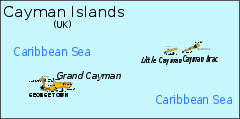Grand Cayman
| Grand Cayman | |
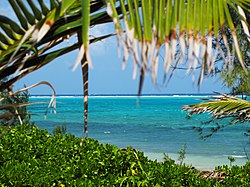 The sea from Grand Cayman | |
|---|---|
| Location | |
| Location: | 19°19’60"N, 81°13’0"W |
| Highest point: | Mastic Reserve; 60 feet |
| Data | |
| Population: | 52,601 (2010) |
Grand Cayman is the largest of the three Cayman Islands and the location of the territory's capital, George Town. In relation to the other two Cayman Islands, it is approximately 75 miles southwest of Little Cayman and 90 miles southwest of Cayman Brac.
Geography
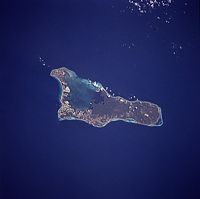
Grand Cayman encompasses 76% of the territory's entire land mass. The island is approximately 22 miles long and at its widest point 8 miles in breadth.[1] The elevation ranges from sea level at the beaches to 60 feet above sea level on the North Side's Mastic Trail.[2][3]
Island districts

Grand Cayman Island includes five of the six districts of the Cayman Islands: Bodden Town, East End, George Town, North Side, and West Bay.[4]
- Bodden Town - Founded in the 1700s, Bodden Town district comprises the central part of Grand Cayman Island, between the George Town and North Side districts. The village of Bodden Town was the original capital of the Cayman Islands. Its population is listed at 5,764.
- East End - The East End district is located at the east side of Grand Cayman Island and consists mostly of the Village of East End, numerous natural attractions, restaurants, and accommodations. Its population is currently listed at 1,371.
- George Town - The capital of the Cayman Islands and world-famous centre for off-shore banking and investments, its population is currently listed at 20,676.
- North Side - Includes Kaibo, Rum Point, and Breakers. Its population is currently listed at 1,079. Sand Point Cove in Rum Point is home to a Bioluminescent Bay or Bio Bay.
- West Bay - Has numerous tourist attractions including the Cayman Turtle Farm and the Cayman Motor Museum. Towns in the West Bay district include Seven Mile Beach, Hell, and West Bay Village. Its population is currently listed at 8,243.
The territory's remaining district is Sister Islands, which consists of the islands of Cayman Brac and Little Cayman.
Birds, beasts and blooms
Plant life
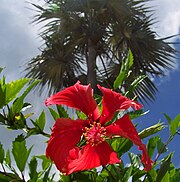
Of the flora, a good representation of the variety of plant life on Grand Cayman can be found at the Queen Elizabeth II Botanic Park located in the North Side District. Wild banana orchids, ghost orchids, thatch palm trees, red birch trees, mahogany trees and various fruit trees such as plantain, mango, breadfruit, and tamarind. Yellow mastics (Sideroxylon foetidissimum), black mastics (Terminalia eriostachya) are also seen in the park as well as on the 2-mile long Mastic Trail passing through the Mastic Reserve. Elsewhere outside the park, all of these species can be seen around Grand Cayman, including coconut palm, Casuarina pine, mangrove, and poinciana (Delonix regia) trees.
Fauna
Fauna seen in various locations around the island include blue iguanas (Cyclura lewisi), Grand Cayman amazon parrots (Amazona leucocephala caymanensis), Central American agouti (Dasyprocta punctata), and Gecarcinus ruricola, a species of land crab.
The Cayman Islands Turtle Farm in the West Bay district raises green sea turtles for their meat and to release into the wild.


Through breeding, the farm produces upwards of 1,800 turtles a year. Between 1980 and 2006, the farm released approximately 30,600 turtles to the wild; because of a mark placed on each animal, the released turtles have been seen throughout the Caribbean.[5]
There are four endemic snake species on Grand Cayman and two invasive species. They are all non-venomous and the largest is the rarely seen invasive corn snake, which may grow to about 5 feet. The smallest grows to just about 6 inches and is the invasive brahminy blind snake. It is also rarely seen. The most common is the endemic Cayman racer snake. It can grow to over 4 feet, but 3-foot specimens are much more common. These snakes tend to race away if encountered and in rare cases will rear-up in a threatening manner if cornered. They have been known to bite, but their teeth are very fine and they barely break the skin. Once captured they quickly become very docile, are easy to handle and rarely bite. They feed on lizards, frogs and juvenile iguanas.
Though not venomous, a Cayman racer snake if cought will excrete a foul-smelling chemical which serves as a self-defence mechanism and a deterrent to predators. The other three endemic snake species are the Cayman ground boa, Cayman blind snake and Cayman water snake.
People
Of the three islands, Grand Cayman contains approximately 95% of the territory's entire population.[6] The population has no dominant race: 40% are of mixed race and those considered broadly black, white or other make up about 20% each.
Economy
Off-shore banking
There are just under 600 banks and trust companies in the Grand Cayman, including 43 of the 50 largest banks in the world.[7] Because of this large financial presence on the island, banking, investments, and insurance drive the economy in Grand Cayman.[8]
Tourism
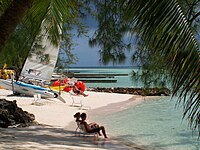
There are fast food restaurants, night clubs, and resorts on the western side of the island down to George Town. The eastern districts have more restaurants specialising in native Caymanian cuisine.
Because of its clubs, resorts, and hotels, Seven Mile Beach has the largest concentration of visitors and tourists on the island.
Watersports such as scuba diving and snorkeling are among the most popular activities on Grand Cayman as the island is known for its coral reefs and underwater sea walls along with a number of shipwrecks.

Grand Cayman Island has a number of natural attractions: the blow holes in the East End district, the Mastic Trail that runs north to south through the center of the island, Hell in the West Bay, and the acclaimed Queen Elizabeth II Botanic Park, to name but a few.
Airport
Owen Roberts International Airport serves Grand Cayman with domestic and international flights. Cayman Airways has its headquarters on Grand Cayman.[9]
Outside links
| ("Wikimedia Commons" has material about Grand Cayman) |
- Cayman Islands Department of Tourism
- Cayman Travel Guide
- Cayman Islands Government
- "National Hurricane Committee - Emergency Management". Cayman Islands Government. http://www.caymanprepared.ky/portal/page?_pageid=1143,1&_dad=portal&_schema=PORTAL. Retrieved 2007-08-18.
References
- ↑ Cayman Islands Tourism website
- ↑ cayman.gov Location and Geography
- ↑ Mastic Trail/highest point on Grand Cayman
- ↑ Statoids.com
- ↑ "Cayman Islands Turtle Farm". http://www.boatswainsbeach.ky/_media/documents/scientific_sea-turtles.pdf. Retrieved 2011-07-09.
- ↑ "The Cayman Islands 2010 Population and Housing Census: Preliminary Report". Economics and Statistics Office. 7 February 2011. http://caymannewsservice.com/sites/default/files/Preliminary%202010%20Census%20Report%20FINAL.pdf. Retrieved 2 June 2011.
- ↑ cayman-information.com Cayman Islands Banking
- ↑ Oxford Economics Study: 55% of the Economy in Grand Cayman is Banking
- ↑ "Cayman Airways
